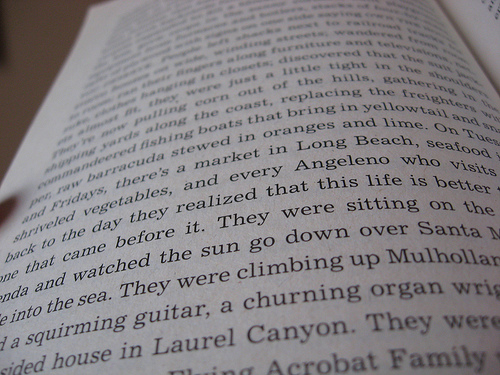In
Who's (...oops!) Whose Grammar Book Is This Anyway? All the Grammar you Need to Succeed in Life, C. Edward Good wrote a chapter entitled "Word War III: Active vs. Passive." Last week, I waged my own war against the passive voice. A client asked me to exorcise the passive voice from his manuscript.
If you've ever taken a writing course, you've heard that you need to always use the active voice, not passive voice. Is passive voice really so bad that we should strike it from
all our writing?
No, not all, but the passive voice is, well, weaker (in many instances) than the active voice. Active certainly brings the reader into the story. But, in my experience, a writer can get into caught up in a scene and write in passive voice until the characters are no longer actively participating. Sure, we can all be lulled into a rhythm of using the passive voice and its hard to snap out of it.
That's where I entered this passive-voice manuscript, knowing that some passive voice is acceptable, but too much can wear down the reader. I was only being asked to tweak the author's use of passive voice. So, I tried a approach you may want to try. On a second reading, I used the "Find" function of Microsoft Word and went to work.I spent several hours massaging a manuscript to use a more active voice.
I searched for the trigger words you might look for when rooting out the passive voice. Those words include:
- be
- was
- have
- had, and so forth...
After I found the words that screamed
PASSIVE VOICE, I read (and re-read) the sections. Then I started rewriting the sections. (Another common word in many passive sentences is "by." You may find that an easier word to search for.)
If you are wondering how much passive voice I cut, this may interest you. During a search of the manuscript, I found 1191 instances of "was" and after my second-pass edits, there were only 547 instances of the word.
Are you a passive voice or active voice writer? Or both? How do you find and edit your passive voice? Elizabeth King Humphrey is a writer and editor. She strives to be more active, but right now is feeling a bit passive.
“Get Rid of Passive Voice” by Joan Y. Edwards
 “A style that consists of passive constructions will sap the reader’s energy. The difference between an active-verb style and a passive-verb style–in clarity and vigor–is the difference between life and death for a writer.” -William Zinsser On Writing Well.
“A style that consists of passive constructions will sap the reader’s energy. The difference between an active-verb style and a passive-verb style–in clarity and vigor–is the difference between life and death for a writer.” -William Zinsser On Writing Well.
The detective waited. He said to the police officer. “I saw it with my own eyes. This author used passive voice in a manuscript.”
The policeman took off his cap, scratched his head and said to the author, “Get rid of it.”
The author put both hands out palms up. “But, Officer, I don’t know how.”
The detective and officer threw up their hands in disgust. They pointed at the author and said, “Learn about passive voice in 24 hours or we’ll book you.”
I hope you enjoyed my humor. I certainly hope you don’t get in a situation like that. However, if you do, I’m here to help you.
Active voice helps insure clarity of meaning. Every word in your manuscript should have a reason for being there. You want each word to carry a clear message in your manuscript. If your manuscript has too many words, eliminating sentences that use passive voice will trim your word count and add to your clarity at the same time. Rambling on and on in passive voice loses readers. Active voice ropes them in and keeps them reading your manuscript from beginning to the very end.
Here is an explanation with examples to help you understand about voice. There are two voices: Active Voice and Passive Voice. Active voice has the noun subject (doer) verb order. The verb to be used as a linking verb shows the condition or existence of the subject. Passive Voice usually uses a form of the verb to be and a past participle of a verb: is, are, was, were, being, had been. The subject is not named before the verb in a sentence using passive voice.
In active voice, the subject does the action. The order is simple – subject followed by verb.
David threw the ball. Who threw the ball? David threw the ball. Examples of sentences using active voice:
- Stephanie lost the money.
- Mother bought jewelry.
- James had sung the songs.
- Nellie was writing letters.
- Phillip was building the dams.
- The hurricane had damaged the houses.
In passive voice, the subject (doer) is not before the verb. The subject is absent or it may come in another part of the sentence.
The ball was thrown. The ball did what? Nothing. It was the receiver of the action. On its own, a ball can’t do anything.
The sentences that follow are in the passive voice. No one knows who did the losing, the buying, or the building. It is not mentioned in the sentence before the verb. The subject is missing. The doer of the action is missing. In passive voice, the direct object of a sentence is written before the verb where the subject usually is. #6 is still a passive voice sentence because hurricane is not before the verb damaged.
Examples of sentences using passive voice where the subject – the doer is missing.
- Money was lost.
- Jewelry was bought.
- The songs had been sung.
- The letters were being written.
- The dams were being built.
- Houses had been damaged by the hurricane.
Think about it. It’s harder for people to read and figure out what’s really going on when authors use the passive voice. Therefore, editors and readers like to read books written in active voice. Search for the passive voice in your manuscript. If you use Microsoft Word, it has a review tool to check spelling and grammar. If a sentence is in the passive voice, it will tell you and suggest that you revise the sentence. Remember when you change the passive voice to the active voice, put the subject (the doer) before the verb.
Click this link to take Joan’s Active-Passive Voice Quiz
Joan is giving three workshops online with the Muse Online Writers Conference in October 7-13, 2013.
http://themuseonlinewritersconference.com/ In August or September, they will open for registration.
Here are the 3 workshops:
How to Write a Pitch That Sells
A Five Day Workshop to help you formulate an enticing, magnetic pitch that no editor, agent, or reader could turn down. Attendees will study the pros, the pitches for the best sellers in your genre and do exercises to build your pitch skills, create and improve a pitch.
30 Ways to Correct, Trim, and Enhance Your Manuscript
Writer will learn how to enhance you manuscript by correcting grammar/punctuation, using vivid showing words with emotional impact and cutting the words that don’t carry the plot, character, and emotional theme forward. Plus a whole lot more.
Become a PubSubber
This workshop provides a way to encourage and empower writers and artists to submit their work for publication
often. Each time you submit a quality work, you increase your chance to be published. This workshop has detailed steps and resources to build the necessary skills to get your submission in the mailbox or sent through email on your personal submission day.
Joan Y. Edwards is an author/illustrator of the delightful picture book, Flip Flap Floodle. She is a consultant, motivational speaker, and teacher. She offers goal-setting, positive thinking, and writing workshops for adults and children. She is a member of Children’s Book Writers and Illustrators (SCBWI) and Catholic Writers Guild. Her articles have been published in SCBWI-Carolinas Pen & Palette and SCBWI Bulletin. Her website, http://www.joanyedwards.com
I’ll remind you of these when registration begins, so you don’t miss signing up if you are interested.
Talk tomorrow,
Kathy
Filed under:
article,
authors and illustrators,
Conferences and Workshops,
demystify,
How to,
need to know,
opportunity,
Process Tagged:
Active Voice,
Get Rid of Passive Voice,
Joan Y Edwards,
Online Writing Workshops 





 “A style that consists of passive constructions will sap the reader’s energy. The difference between an active-verb style and a passive-verb style–in clarity and vigor–is the difference between life and death for a writer.” -William Zinsser On Writing Well.
“A style that consists of passive constructions will sap the reader’s energy. The difference between an active-verb style and a passive-verb style–in clarity and vigor–is the difference between life and death for a writer.” -William Zinsser On Writing Well.
I probably use passive voice too much. I write memoir, though, and when writing about the past it's difficult to NOT use "was" and "had". Great article!
Becky:
You don't. :) I checked yours for this. :) HA! And using was sometimes is fine.
Elizabeth: GREAT ARTICLE. I love your idea for searching those words and reading those sections they come up in over to see what you think about your own passive-voice use. Thanks for sharing how you cut the "was" use in half, too. Strong verbs are so important. We are going to have an article in the upcoming issue (NEW ISSUE LIVE VERY SOON!) where one of the writers tackles passive voice using some Word tools, too. Very interesting!
This is definitely an area in which I need to be more actively aware. I have Jessica Bell's book (--> over there in margin) on my to-buy list just for just this reason. Thanks for the reminder.
Great reminder to keep our voice active. I like the idea of searching for specific words that can tip us off to excessive passivity in our writing. Oddly, when I was in fourth grade, I had to memorize the entire litany of passive verbs and can recite them to this day—is, am, are, was, were, be, been, being, have, has, had, should, would, could, shall, will, can, may, might, must, do, did, does. Whew! Clearly, the future writer in me knew they would come in handy one day, even if it was to help me avoid them!
This is totally off topic, but I've been to the Long Beach farmer's market they are talking about in that little photo! I actually go there all the time. LOL!
Wonderful post, Elizabeth! That is so interesting how you search for passive sentences with Word's Find function. I'm a constant passive sentence checker and have a bad habit of using Word's Readability tools after I write a paragraph. But your idea of using Find for certain words is probably a more accurate and thorough edit of these offenders.
I second Margo's comment about the issue. It's fantastic, and can't wait until it publishes. The revision and self-editing techniques in the issue are ones that I'm looking forward to trying for my WIP. We had a blast, too! Margo did a wonderful job editing, and I had so much fun with the artwork. Some of the headers I created for the issue are among my faves.
Revisiting this topic is always helpful to me, so I'll definitely take a look at the WOW article!
Since I teach English & Journalism, I remind students to use active voice, but sometimes, passive voice has its place, primarily when the "actor" in a sentence is unknown or unimportant (Example: The Internet was establishined in 1969 by the US Department of Defense).
Another phrase to search for with the find function: there is or there are. These phrases raise red flags, signaling "passive voice resides in this sentence!!"